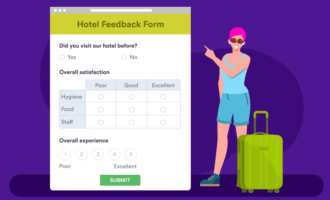Surveys are an excellent way to get people to volunteer information they might not normally share. A business might survey prospects to get a deeper understanding of their needs and goals in order to improve its product offerings. Or it might survey employees to learn how engaged they are and whether they have any ideas for improving the workplace.
When you’re designing a survey, regardless of what it’s for, you’ll need to use the right type of questions to get the most useful information. Open-ended survey questions are a good choice when you want more context or details from your respondents.
The purpose of open-ended survey questions
An open-ended survey question allows respondents to answer in their own words instead of choosing from a set of possible answers. An open-ended survey question often prompts more meaningful, detailed responses because the respondents get to speak their minds freely.
“Usually, the surveyor wants you to elaborate on your answer so they can get a more complete picture of your perspective on a given topic,” says John Li, cofounder and CTO of Fig Loans, an organization that offers credit-building alternatives to payday loans.
This type of question also enables the respondents to add their own knowledge, perspectives, and experience when answering. Answers to open-ended survey questions are often more personal, as they typically include the respondent’s feelings about a topic.
Open-ended survey questions vs closed-ended survey questions
The opposite of an open-ended survey question is a closed-ended question. This type of question comes with a selection of pre-written answers for the respondent to choose from. The goal of closed-ended survey questions is to get answers that are quantifiable.
“For example,” says Li, “a question may give you the option to respond yes/no or to choose from answers A, B, C , or D. A closed-ended question often contains a scale, asking you to rate something from 1–5 or to put items in the order of most to least important. With a closed-ended question, you choose from the answers given to you, rather than craft your own.”
In contrast, open-ended survey questions provide a more qualitative set of responses. These responses may not be easy to organize in a graph like the results of closed-ended survey questions, but they offer unique and personal insights from respondents that can be immensely valuable to a business.
But there’s no need to choose between the two types of survey questions. Many surveys include a combination of open-ended and closed-ended questions, giving the organization a comprehensive set of qualitative and quantitative data from the responses.
When to use an open-ended survey question
When you’re designing a survey, how do you know whether to use an open-ended or closed-ended survey question?
“The open-ended question helps you uncover the motivations and feelings of individual respondents, giving more context to their ‘why,’” says Li. “Closed-ended questions, on the other hand, are helpful to ask when you simply want respondents to confirm their thoughts and feelings toward a topic.”
What kind of question will get you the best response and encourage the respondent to provide an insightful answer? Here are some situations where an open-ended survey question would work best.
If you have a small group of respondents
The answers to an open-ended question may contain several sentences or paragraphs, so it’s important to be sure you have the bandwidth to be able to comb through each response in detail. Typically, open-ended questions work well when you’re dealing with a small audience, as it’s easier to dedicate time and effort to reading through and understanding the responses. Closed-ended questions work well for both small and large audiences.
If you’re soliciting feedback
If you want to know what people really think about a topic, use an open-ended question. This way, they can share their true feelings, needs, and goals, instead of having to select pre-written answers that may not fully sum up their thoughts. For example, if you want to ask customers for the challenges they experience or ask employees for their thoughts on a particular company initiative, you’ll get more information with open-ended questions.
If you’re conducting preliminary research
Some organizations use open-ended questions to determine the types of responses they need to include in a larger survey with closed-ended questions. For example, before sending out a market research survey about buying habits to a large audience, a company may send a survey with open-ended questions to a small audience and ask how they feel about spending versus saving. The answers they get from that survey can inform the response options they’ll include for a closed-ended survey intended for a larger group of people.
If you want more context for answers to closed-ended questions
Many surveys use open-ended questions as a follow-up to closed-ended questions. For example, a closed-ended question may ask a respondent to rate a specific product, and an open-ended question may follow that asks them why they’ve chosen to give that rating. This way, the organization gets both quantitative and qualitative answers for the same question.
“You’ll allow them to give context for their answer, gaining you critical data that can help you learn their most significant pain points,” says Li.
The benefits of open-ended survey questions
Why choose open-ended questions to be a part of the survey? There are many advantages to using this format.
- New insights: Respondents may provide answers the organization hasn’t thought of before, leading to new perspectives that may impact future decisions at the company. For example, if one of the questions is about how to improve a particular product, respondents may offer design or functionality ideas that the company hasn’t yet considered.
- Free rein: Unlike closed-ended questions, open-ended questions give respondents the freedom to answer as they choose. They can be positive, negative, or both, and they can speak from the heart because there are no limits. With closed-ended questions, the answers they have to choose from may not fully cover how the respondent was thinking or feeling.
- Additional context: With open-ended questions, organizations may get additional details about certain topics that they weren’t privy to before or wouldn’t have the opportunity to get with closed-ended questions. This is particularly true when using open-ended questions to follow up on closed-ended questions.
Li offers an additional tip: “Keep the open-ended questions optional, so those who don’t have more to say can move on. Leaving your questions optional will result in fewer responses overall, but the ones you get will be higher quality and more truthful from the respondents who felt compelled to share their stories.”
Examples of open-ended survey questions
Not sure what an open-ended question actually looks like? Below are some examples. Keep in mind that you can use these as open- or closed-ended questions — the only difference is whether you provide respondents with pre-written options to choose from or an empty text box.
Customer-facing questions
- How was your experience at our store today?
- What can we do to improve our products to better meet your needs?
- How comfortable do you feel recommending our business to a friend?
- Would you buy this brand?
- Why would you decide to choose a different service over ours?
- What is the most memorable part of your experience with our business?
- Did we meet all your needs today?
Employee-facing questions
- If a friend asked you what it’s like to work here, what would you tell them?
- What is your favorite thing about coming to work each day?
- What is something you would like to change about the company culture?
- What motivates you to get out of bed each morning?
- Why are your skills and experience right for this position?
- Can you write down the steps for this specific business process?
- What do you want to achieve in the next five years?
Open-ended survey questions with Jotform
Whether you want to create a survey with open-ended questions, closed-ended questions, or a combination of the two, Jotform can help you do it. Ideal for creating surveys for any industry in any business scenario, Jotform has thousands of templates to get you started. Each survey template is fully customizable — you can choose from an array of question types, change the colors to fit your brand, and more — so you can create one that suits your organization’s goals.
“The beauty of the open-ended question is that you often find surprising results that uncover issues and opportunities you didn’t consider beforehand,” says Li. Ready to get meaningful insight from your audience? Start creating your survey with Jotform today.







































































































Send Comment: